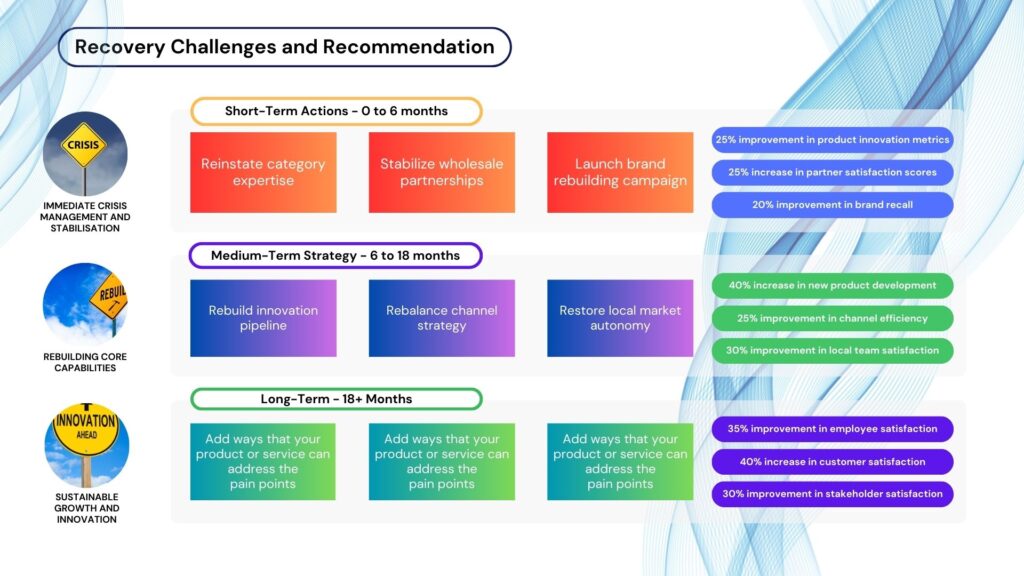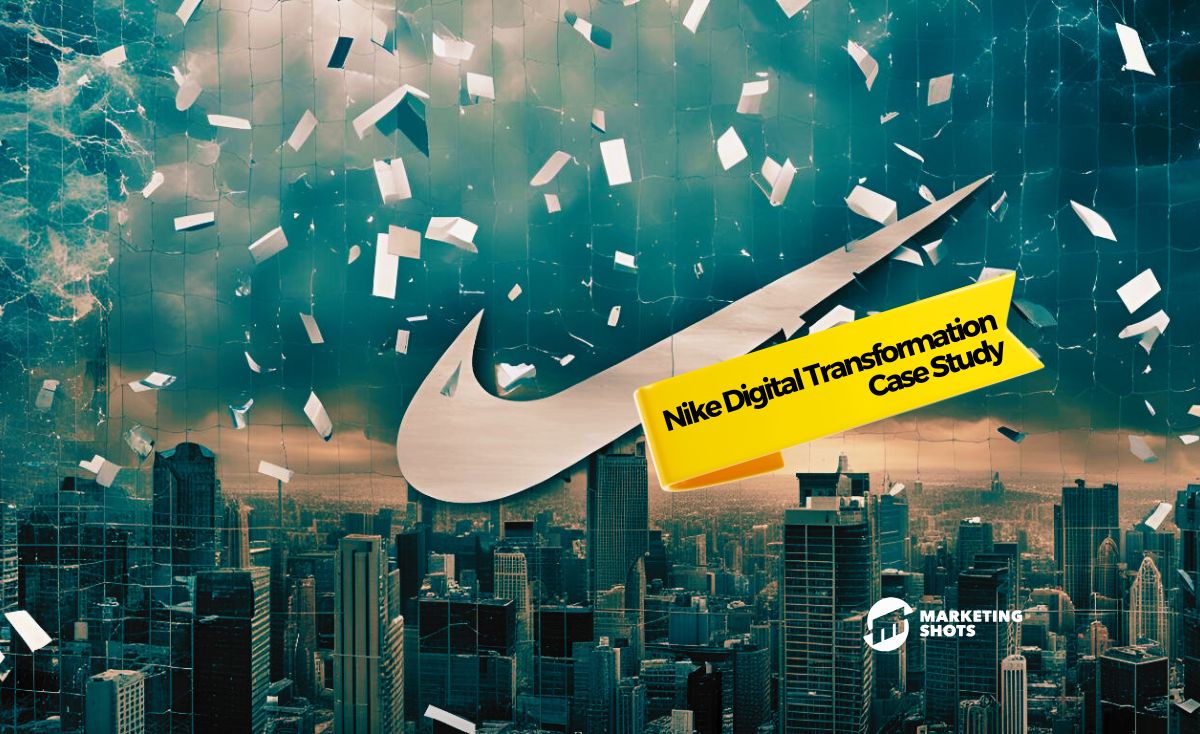Digital Transformation Case Study for Business Professionals
Executive Summary
In one of the most dramatic corporate value erosions of 2024, Nike, the world’s leading sportswear brand, lost $25 billion in market value in a single day, cumulatively $70 billion erosion over nine months. This case study dissects the digital transformation initiatives under CEO John Donahue, who became responsible for this unprecedented decline. This Digital Transformation Case Study will analyse the series of events through the lens of established business frameworks and narrate a story about digital technology horror.
Key Metrics
Stock Performance: -32% (2024 YTD)
Trading Volume: 130M shares (13x normal)
Market Cap Loss: $70B (9 months)
Gross Margin: Declined to 43.5%Company Background
Nike was founded in 1964 and built its empire on three core pillars ~
- Cutting-edge product innovation
- Powerful, emotionally resonant brand storytelling
- Deep, authentic customer connections
- Sports celebrity endorsement and aspiration-building
- Business process balancing manual processes and digital initiatives
By 2020, Nike’s market valuation exceeded $200 billion, cementing its dominance in the global sportswear market. The company’s success was rooted in its ability to blend technological innovation with marketing excellence, creating a seemingly unassailable market position.
Nike’s Digital Transformation Challenge
Nike prioritised Digital Transformation in 2020 in response to industry trends, competitive pressures, and latent demand from the board.
Threat of New Entrants – High-Risk
- Digitally, Native Brands like Allbirds and OnRunning were entering the market with D2C Models that used emerging technology, data-driven operations, and lower overheads.
- Amazon’s business strategy and expansion into sportswear posed a significant threat. Amazon had all the resources to scale up its business.
- Online advertising and influencer marketing increased the barriers to entry and made it easier to reach consumers directly.
Digital Transformation Implication – Nike must strengthen its digital strategy and capabilities to be more agile and swift.
Bargaining Power of Suppliers – Moderate Risk
- Nike had to integrate digital transformation backwards to make its suppliers more agile and make a tech-enabled manufacturing process.
- Nike saw digital transformation to gain real-time insights into its complex global supply chain.
Successful Digital Transformation could help Nike better manage its supply chain and reduce dependencies on traditional manufacturing processes. If a success, it could lead to $2 billion in cost savings over five years through improved efficiency and reduced overhead.
Bargaining Power of Buyers – High and Increasing
- Armed with more information, digitally savvy customers, particularly younger demographics, have significantly amplified their bargaining power, driving a shift towards discount shopping and demanding a completely redefined customer experience.
- Customers increasingly expect personalised products and experiences, leading to customer data growth.
- By 2019, global e-commerce sales had reached $3.5 Trillion. Consumers rapidly shifted to hybrid and direct brand engagement, altering traditional buying patterns.
Digital Transformation implications: Nike must enhance its digital capabilities to generate valuable insights, meet evolving customer needs, and maintain customer loyalty.
Threat of Substitute Products – Moderate to High risk
- Athleisure started trending, diffusing the line between sportswear and casual wear and attracting new competitors from the fashion and lifestyle sectors.
- Digital fitness via online fitness apps has begun impacting traditional sportswear demand.
Digital Transformation Implication: Nike needs digital tools and advanced analytics to stay relevant and modern for existing customers and attract new ones.
Rivalry among Existing Competitors – High Risk
- Adidas’s digital innovation was getting 20% of its sales from online channels and setting ambitious future targets.
- Competitors invested heavily in digital platforms, digital marketing, social media, e-commerce technologies, data infrastructure and programmatic advertising capabilities, thereby starting a Digital Arms Race.
- Omnichannel integration, i.e. seamless integration of online and offline experiences and inventory availability, was driving digital transformation success.
Digital Transformation implication – Nike risked falling behind its competitors If it didn’t accelerate its digital transformation agenda.
While Nike initiated its Digital Transformation Journey in 2019, the 2020 pandemic accelerated their urgency. Store closures and changing consumer behaviour made a robust digital presence advantageous and essential for survival.
Strategic Analysis of the Digital Transformation Case Study
Nike’s Category Management Crisis
Nike restructured its category management approach to increase efficiency, leveraging data analytics. We will scan this decision using the McKinsey 7S framework to understand how changes in one area caused a domino effect in all aspects of Nike’s operations.
- Structure: 70% elimination of category experts
- Skills: Loss of specialised knowledge and created generalised teams
- Systems: Replaced category-specific strategy with data-driven systems
- Style: Shift from expertise-led to data-led decision-making
- Staff: Mass exodus of experienced personnel and replaced with Generative AI-ML Professionals
- Strategy: Replaced category-specific approach with one-size fit all approach
- Shared Values: Shift from product excellence to emphasis on digital metrics and data-driven growth
Impact: $15 billion in value erosion.
The overreliance on data analytics without domain expertise caused a significant disconnect between siloed Digital Transformation initiatives and market realities. The data-driven approach generated a lot of data and insights disconnected from digital customer expectations and real-market and human insights.
Distribution Strategy Blunder
The Nike Digital Transformation Case Study is a classic example of the negative impact of force-fitting transformation on business-critical operations. Let’s view it from Porter’s Value Chain Analysis.
- Inbound Logistics: A shift from just-in-time practices to Inventory bloat ($6.5B to $10B)
- Operations: Terminated wholesale partnerships, which caused a loss in economies of scale
- Outbound Logistics: Bulk distribution to wholesale partners Vs D2C kept logistics cost in cheque
- Marketing & Sales: Initial increase in D2C revenues. Acute loss in casual customers due to reduced physical distribution.
- Service: Nike erased its thriving strategy of personalised selling by in-person fitting advisors and fitness experts.
Impact: $20 billion in value erosion.
The company’s aggressive push towards D2C channels and industrial automation disrupted Nike’s well-established, efficient process without testing the new approach.
Marketing Transformation using the Marketing Mix Model
Nike’s digital transformation of the marketing department led to significant changes in its marketing strategy. The analysis below, using the marketing mix model, will help us understand how these changes resulted in substantial value erosion and long-term brand challenges.
- Product: Significant Innovation decline owing to generalised product strategy.
- Price: From premium pricing supported by substantial brand value, overdiscounting led to margin compression from 46% to 43.5%.
- Place: Nike’s new Digital Transformation Strategy killed the right mix of wholesale partnerships, Nike-owned stores, and e-commerce to push towards a D2C-only strategy aggressively.
- Promotion: Nike’s new marketing strategies diluted brand-building and performance marketing campaigns and relied heavily on digital and programmatic advertising.
Impact: $25 billion in value erosion
This destroyed the customer experience. Digital platforms generate ample data contextual to your targeting but lack intent signals beyond clicks and pageviews. Therefore, sales attribution to marketing efforts isn’t accurately measured, leading to inefficient allocation of marketing resources.
Nike’s Organizational Restructuring Blunder
Restructuring or any organisational change impacts the basic fabric of the company, and if leaders don’t carefully consider their decisions, they can cause irreversible damage to culture and motivation. The digital transformation case study highlights critical failures in change management and user experience.
- Failed to create sufficient urgency – leadership didn’t present compelling evidence for the need for change.
- Nike didn’t pursue a mix of digital and sports industry expertise, leading to a weak guiding coalition.
- Unclear vision communication for new ways of digital transformation, which lead to a 50% increase in departmental conflict
- Insufficient employee empowerment: The company didn’t focus on comprehensive digital skills training, so 55% of employees felt unprepared for new roles.
- Nike didn’t set clear milestones and celebrations for short-term wins, which dented employee morale and created fear.
- A premature declaration of victory failed to address core problems. Once the initial gains were lost, the company faced multiple failures.
Impact: $10 billion in value erosion.
Nike felt disconnected from its sports heritage. A lack of proper change management and adoption of new working methods led to significant organisational challenges and value erosion, thus failing the digital transformation initiative.
Nike’s Recovery Roadmap: A Three-Phase Transformation Strategy
This recovery roadmap represents a comprehensive approach to rebuilding Nike’s market position while embracing digital maturity in a more balanced and sustainable way. Each phase builds upon the previous one, creating a solid foundation for long-term success.

Critical Lessons for Business Leaders
- The Expertise Paradox: Digital transformation should enhance, not replace, core expertise.
- Channel Evolution: You cannot force the evolution of customer behaviour.
- Brand Building: Long-term brand equity trumps short-term performance metrics.
- Change Management: Transformation requires balanced preservation of core strengths.
- Strategic Patience: Sustainable transformation requires appropriate pacing.
- Marketing Horror: Any technology initiative, whether artificial intelligence or machine learning, should align with business goals, not vice versa.
Discover how certain marketing missteps can derail a seamless customer journey in our in-depth analysis on marketing mistakes that harm customer experience. Learn actionable insights to avoid these pitfalls and enhance customer satisfaction through well-aligned marketing strategies.
Discussion Questions
Critical questions that are being answered via this Digital Transformation Case Study on Nke’s $70 billion value loss
Digital Transformation and Leadership Challenge
How could Nike have better balanced digital transformation with core competency preservation?
- Implemented a staged digital transformation rather than rapid overhaul, allowing gradual integration of new technologies while maintaining existing strengths.
- Created hybrid teams merging digital experts with seasoned category specialists instead of replacing experienced staff with tech-focused newcomers.
- Adopted AI and data analytics to enhance, not replace, human expertise in product development and category management.
- Maintained a balanced distribution strategy by digitally enabling wholesale partnerships while developing direct-to-consumer channels rather than forcing a digital-only approach.
- Preserved brand storytelling and emotional marketing while adding digital capabilities instead of switching entirely to performance marketing.
- Developed technology systems that supported existing successful processes rather than disrupting them with entirely new approaches.
- Focused on augmenting physical retail experiences with digital features instead of eliminating traditional customer touchpoints.
What role did leadership transition play in the strategic missteps?
- New CEO John Donahoe’s tech-centric background (from eBay and ServiceNow) led to an overemphasis on digital transformation without fully understanding Nike’s core sports industry dynamics.
- Leadership team composition shifted heavily toward tech executives, losing critical sports industry expertise and institutional knowledge.
- Top-down implementation approach without adequate consultation with experienced category leaders and regional managers.
- Rapid organizational restructuring without proper change management or consideration for Nike’s established culture and values.
- Premature celebration of digital transformation success before ensuring sustainable implementation and employee buy-in.
- Failure to build a diverse guiding coalition that balanced digital expertise with sports industry knowledge.
- Centralized decision-making that reduced local market autonomy and responsiveness to regional customer needs.
- Misalignment between leadership’s digital vision and the reality of Nike’s core customer experience and brand value proposition.
- The short-term focus is on digital metrics and efficiency over long-term brand building and customer relationships.
- Insufficient attention to preserving Nike’s performance-driven culture during the transformation process.
Way Forward for Nike
How might Nike rebuild its brand equity while maintaining digital progress?
- Launch an integrated brand campaign combining traditional emotional storytelling with digital engagement, reinforcing Nike’s core values while showcasing digital innovation.
- Re-establish athlete partnerships and sports category expertise using digital platforms to enhance consumer connections and product insights.
- Balance performance marketing with brand-building activities, using data analytics to optimize both approaches rather than focusing solely on short-term metrics.
- Create an omnichannel strategy that blends physical and digital experiences, ensuring consistent brand messaging and customer experience across all touchpoints.
- Leverage AI and data analytics to enhance personalization while maintaining Nike’s aspirational brand positioning.
- Restore local market autonomy supported by centralized digital capabilities, allowing culturally relevant brand expressions with technological efficiency.
- Develop hybrid retail experiences that combine Nike’s traditional experiential strengths with digital convenience.
- Use digital platforms to amplify authentic brand storytelling rather than replace it with purely transactional content.
- Implement balanced KPIs that measure both brand health and digital performance metrics.
- Create compelling digital content that maintains Nike’s emotional connection while leveraging new technology capabilities.
What lessons can other global brands learn from Nike’s transformation crisis?
- Digital transformation should enhance rather than replace core brand strengths—it should preserve what makes the brand successful while modernizing operations.
- Change management is crucial – proper planning, communication, and employee engagement are essential for successful transformation.
- Maintain balance in leadership teams – combine industry expertise with digital knowledge rather than skewing heavily toward one side.
- Pace transformation appropriately – rushing digital changes without proper foundation and buy-in can lead to significant value erosion.
- Protect brand equity – don’t sacrifice long-term brand value for short-term digital efficiency gains.
- Preserve customer relationships – maintain valuable traditional touchpoints while adding digital channels rather than forcing customer behaviour changes.
- Value institutional knowledge – experienced employees carry critical insights that shouldn’t be discarded for new digital talent.
- Implement hybrid approaches – blend digital capabilities with traditional strengths rather than completely replacing existing systems.
- Monitor digital and traditional metrics – don’t focus solely on digital KPIs at the expense of brand health indicators.
- Local market consideration – maintain flexibility for regional needs while implementing global digital strategies.
Conclusion
Nike’s case demonstrates the delicate balance required in corporate transformation initiatives and customer experience. While digital transformation is crucial for modern business success, preserving core competencies, brand equity, and customer relationships remains paramount. The company’s recovery will depend on its ability to rebuild these foundations while maintaining its digital progress.
Note: This case study, based on public information, international journals, and market analysis as of 2024, is a valuable learning tool for understanding the challenges and strategies of corporate transformation.






